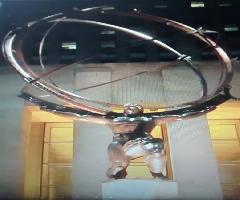Beginning in October, nine to 14 year olds from all over Westchester gave up Saturdays and assorted weekdays in exchange for an activity that might seem more suited for preschoolers - building with Legos. Only their participation in the First Lego League, which culminated in a regional competition at Pace University on March 13, ranks far from child's play.
Meaning that to imagine dropping 20,000 leagues to fix a pipeline with Legos might come easier if your four, but envisioning it beneath the sea is something that might fill the Saturday of an actual Oceanographer. This thus served as
It then left the children to substitute an 8 by 4 foot table for the ocean floor and utilize their miniature robots as if they were real. Although unlike their early childhood, these engineers didn't have to spend their Saturdays wondering what it would be like if their plastic pieces only had a brain.
Missions, such as rescuing a dolphin or recovering archeological artifacts, are planned by the league and a programming software called Mindstorm put the robot’s ability to think and move into the hands of the children.
"I love computers, I like programming and I like Legos," says 11 year old Davis Wertheimer of why he participated with the Alpha Omega team despite the many hours invested. The all boys team from Seven Bridges finished 1st in Robot design, but fell short of winning the director’s award, which combined Research, Technical Ability, performance and teamwork with design.
Marching on Atlanta April 27th with their award to face worldwide competition will be the Techno Girls. Affiliated with the Girl Scouts, they began the season struggling to get their robot to move straight. Only after deciding to scrap version 1.0 would they begin moving forward, but they still finished round one with a score of just 10 in performance.
The hung in as others teams scored as high as 400 with the inspiration of their Junior coach Olivia Rerek, according to Claire Diehl of North Salem Middle School. "She thought we would be able to do it, said the 12 year old, "even if we didn't think so," and the Techno girls weren’t the only ones lacking belief.
They often heard chatter that went contrary to the outcome, according 10 year old Maya Anand from Robert E. Bell. For instance, she says, comments like, "Oh, we're competing against girls, this is going to be easy." On the other hand, proving them wrong, she said in hardly being able to contain her enthusiasm, "felt really good."
Still, the Alpha Omegas felt satisfied by their design while learning something about teamwork. Using a programming language of pictures, robots used sensors to move toward mission completion. Of course, with the trial and error tribulations of any technology, they ran into walls and differed on solutions.
“Sometimes people stopped cooperating and you couldn’t get anything done,” said 11 year old Archit Verma. Taking the advice of their coach, Dr. Dinesh Verma, the boys would vote on a course of action and the results speak for themselves.
Also Archit's father, Dr. Dinesh was surprised by their approach to troubleshooting and the creativity they exhibited. "I'll confess, these kids are better than me," he said, and that coming from a computer researcher employed at the Thomas J. Watson Center.
Falling a little short to him in that department, Techno’s coach still managed to maximize her knowledge to the benefit of her team. "I'm not a genius, I'm someone who got the girls fired up and got them moving in the right direction," said Ann Marie Imbriale, a former community director with the girl scouts.
But sending them south above the competition derived also from their research project. Required to solve a real world problem, the girls rolled across reef balls.
A cone shaped object made of cement, sand and microsilica, the device attracts oysters and they filter pollution from the ocean as they feed. Taking their presentation up a notch, they got a grant, bought the materials and will partner with the River Project in New York City this May to deploy the ball and continue to monitor it in the future.
"You build it and they will come," said Ms. Imbriale, as she commented on the importance of the FLL for children – and especially girls. "A lot of them didn't realize the potential and the future they could have before the robotic group and now half of them want to be engineers and aspiring scientists," she said.
More kids stuff
http://expertscolumn.com/content/pearl-river-middle-school-teacher-has-design-change-gandhis-name
Mamaroneck High School Students for Senegal http://expertscolumn.com/content/senegal-mamaroneck-literacy-africa


